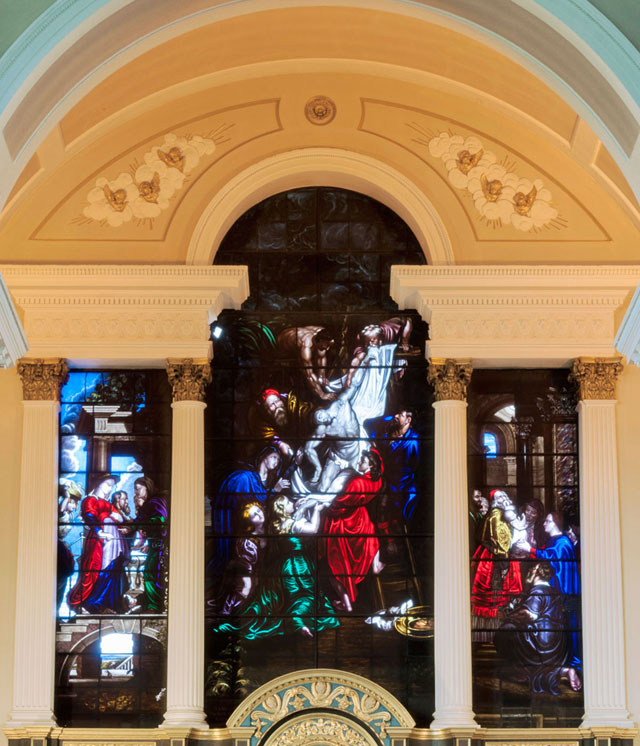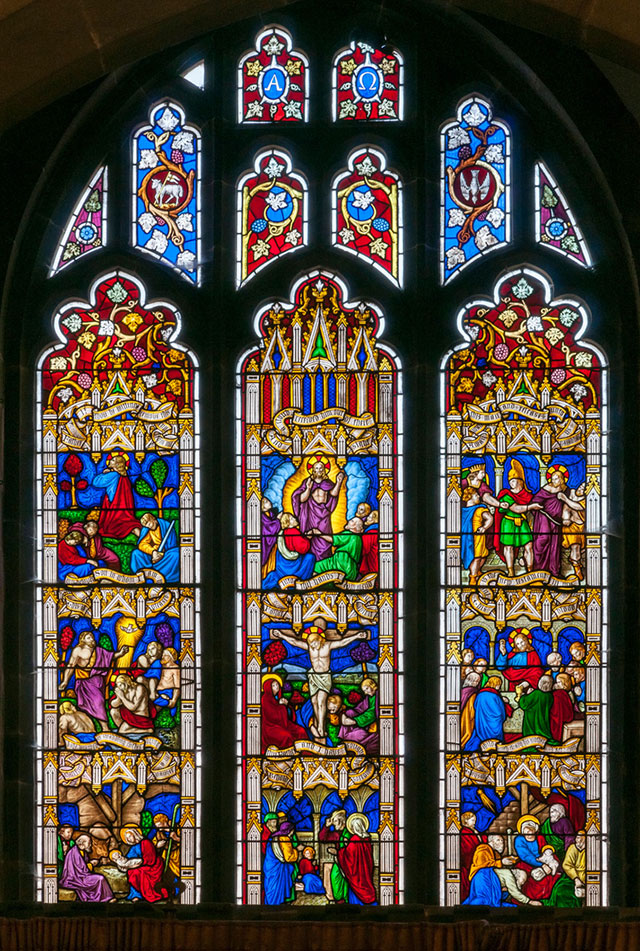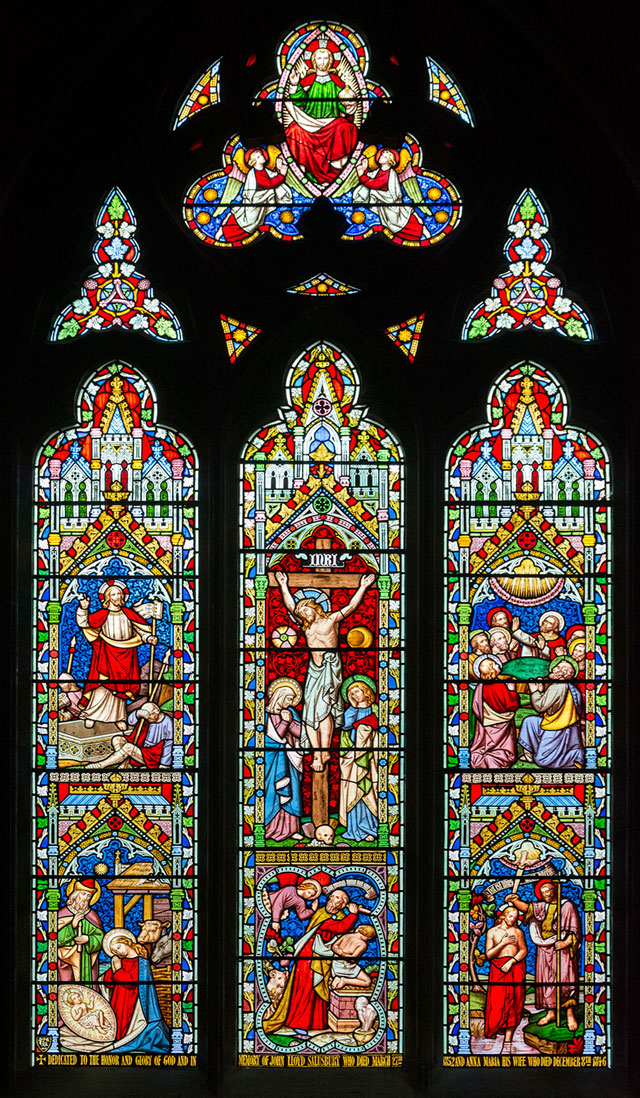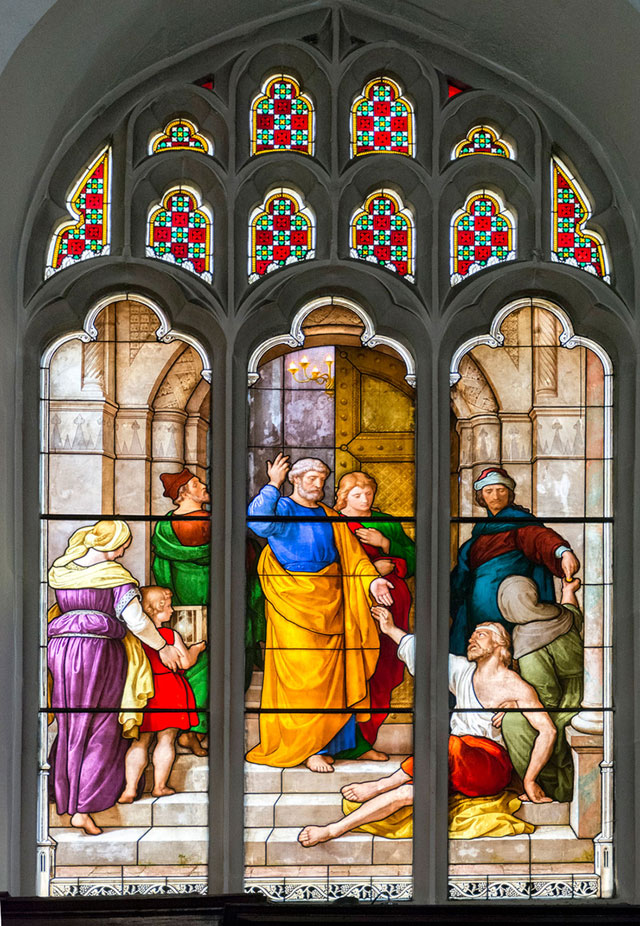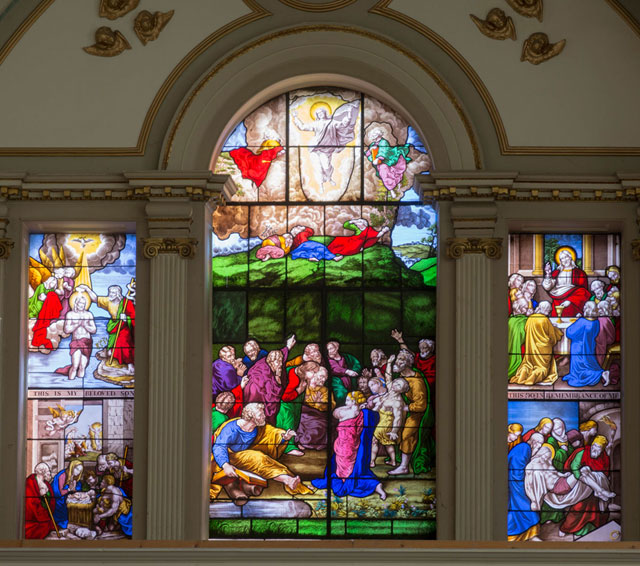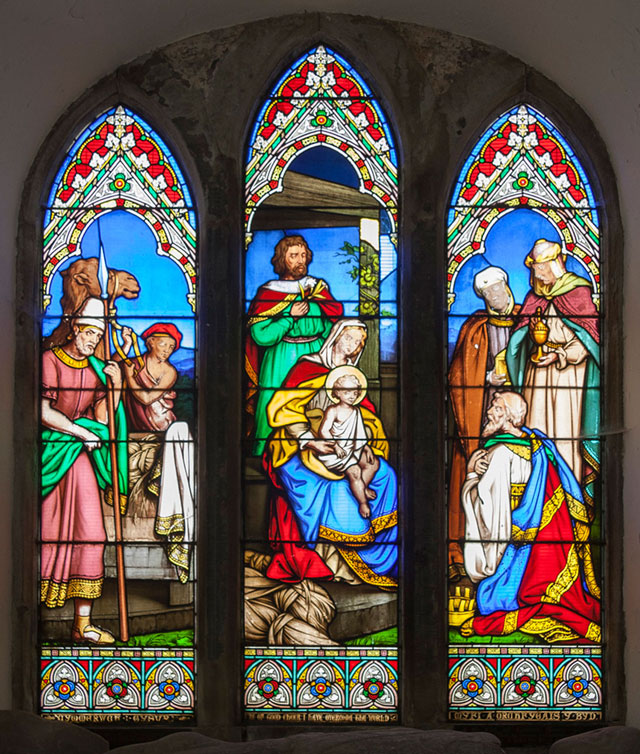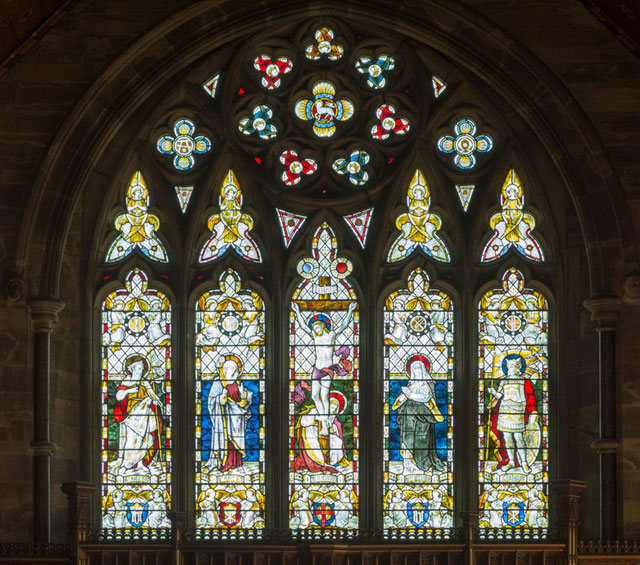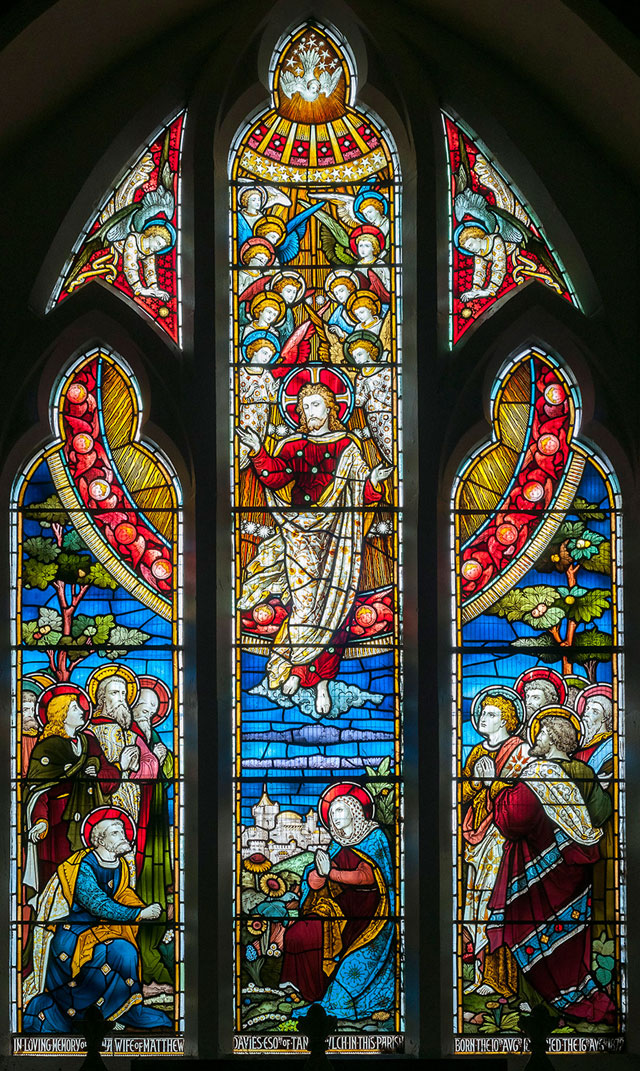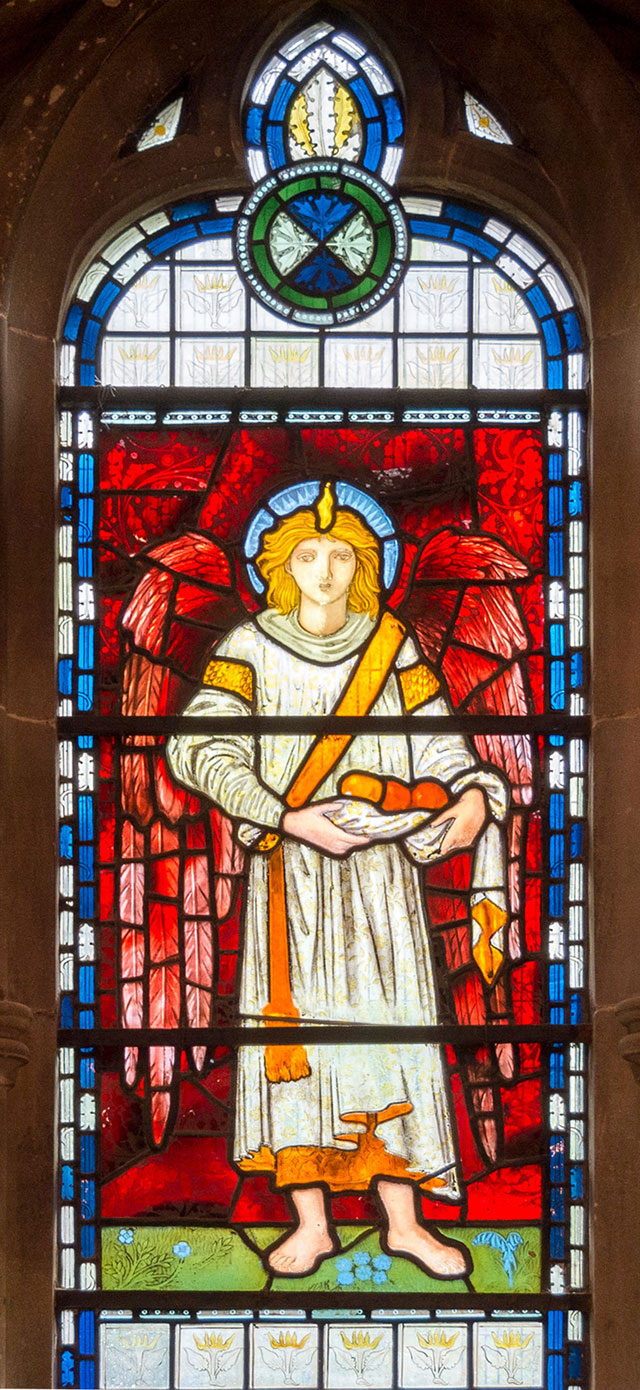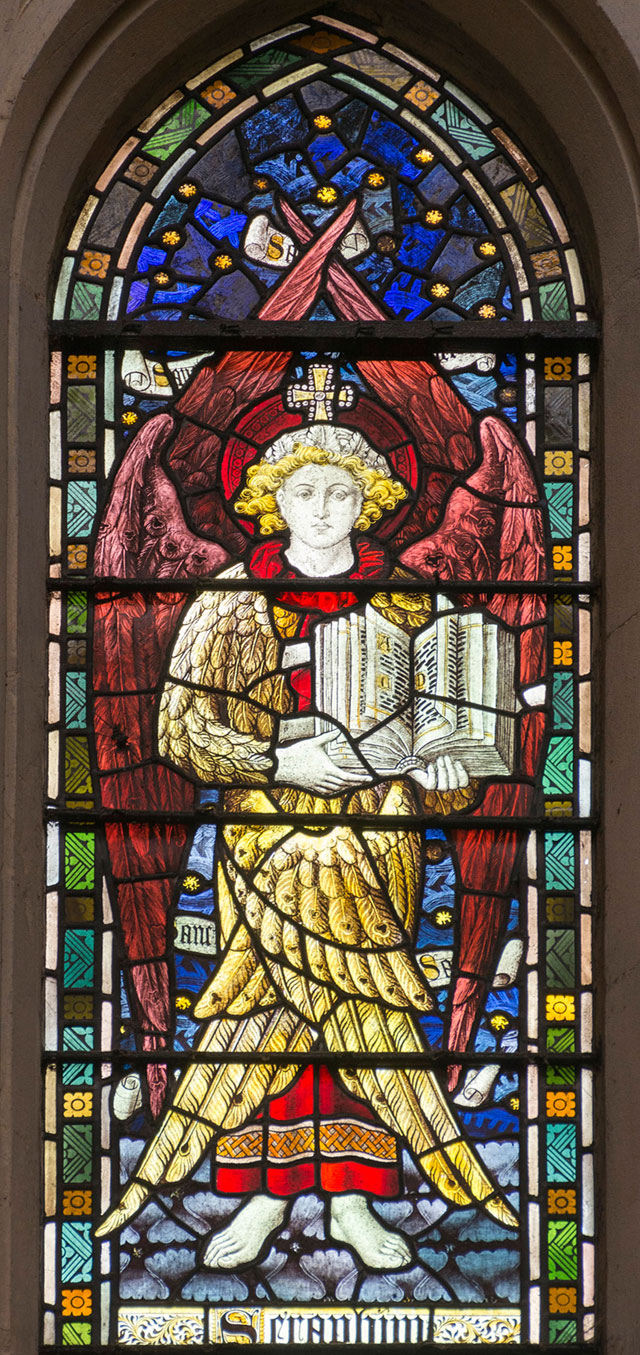The vast quantity and variety of nineteenth-century stained glass presents serious challenges to those who would venture to make generalizations about it. The 1850s and 1860s saw a rapid expansion in demand, and the popularity of the Gothic Revival as an architectural style, particularly for churches, resulted in the establishment of a multitude of firms making stained glass in towns and cities across Britain. Their output ranged from patterned windows with geometric and foliate decoration to large pictorial works, and was produced by teams of skilled designers, cartoonists, painters, glaziers, and technicians. Tens of thousands of windows were produced for churches alone, but a tiny proportion has been studied in any detail. Much has not even been dated and attributed. While the names of some nineteenth-century stained glass designers are well known, notably William Morris (1834–1896) and his friend Edward Burne-Jones (1833–1898), as well as the architect A. W. N. Pugin (1812–1852), they are more commonly celebrated for their work in other artistic media. By contrast, the names of equally important designers of the medium — William Wailes (1808–1881), John Hardman Powell (1827–1895), John Richard Clayton (1827–1913), Charles Eamer Kempe (1837–1907), Henry Holiday (1839–1927), and Christopher Whall (1849–1924) — are familiar to enthusiasts of the medium and as names in the Pevsner architectural guides, but are unlikely to attract crowds of admirers to a retrospective exhibition.
The neglect of stained glass and its designers and makers as a subject for study has its roots in nineteenth-century debates about the boundaries between art, craft, industry, and business.1 The status of stained glass as an art was questioned by those that perceived it as an industrial process, and the sheer quantity that was produced inevitably bowed to commercial constraints. ‘Trade rushed in where artists scorned to tread,’ lamented the artist and designer Henry Holiday in 1896, ‘and the supply was soon equal to the demand.’2 Ninety-nine per cent of stained glass, he claimed, was not art. It was conventional and repetitive, being produced for the profit of company proprietors, and to the detriment of artists and workers alike (p. 5). Having designed windows for the stained glass studio of James Powell & Sons for more than twenty-five years, in 1891 Holiday set up his own studio to make his own windows.3 His criticisms were echoed in the emerging ideals of the Arts and Crafts Movement, becoming part of a critique of Victorian stained glass that was to be highly influential in the twentieth century.
Writing in 1977, the influential stained glass artist and teacher Lawrence Lee (1909–2011) dismissed nineteenth-century Gothic Revival stained glass out of hand: it ‘expressed itself mainly in attempts by “trade” studio glass painters to copy the painting techniques of the fourteenth- and fifteenth-century glaziers. They were lifeless, stereotyped, utterly without conviction.’4 By contrast, ‘[a] Pre-Raphaelite window,’ wrote Lee ‘for all its dated quality, can still be picked out among duller nineteenth-century companions’ (Appreciation, p. 76). Writing in the twentieth century, both Lawrence Lee and John Piper (1903–1992), a distinguished twentieth-century artist who designed much stained glass in the post-war period, commended the work of Morris, Marshall, Faulkner & Co., established in 1861, as of a higher order. Lee credited this firm with setting in motion ‘a movement which ran completely counter to the falsities of the Gothic Revival’.5 Piper wrote of ‘a touching and haunting quality’ in their earliest work, ‘like wild flowers or birdsong’, while the windows that followed ‘are remarkable for freshness and beauty’.6 Piper also characterized Morris as a reformer who ‘went against the stream of commerce’ and a ‘prophet’ who ‘led the way back to Mother Art, who had been out of sight behind the imitations of imitations by the later Gothic Revivalists’ (p. 34). In this context it is not surprising that Morris & Co. was the first Victorian stained glass studio to be provided with a history and catalogue of its own, or that it has remained so prominent in subsequent general accounts of the field.7 Windows by Morris & Co., and especially those designed by Edward Burne-Jones, are invariably — and sometimes indiscriminately — valued above most Victorian stained glass, as a result of the popularity of Burne-Jones’s style of Pre-Raphaelitism and Morris’s status as a conveniently progressive activist and champion of the emergent Arts and Crafts Movement during the 1880s and 1890s.8
The bias against much stained glass produced in the nineteenth century remained strong throughout most of the twentieth century. In 1941 the News and Notes section in the Journal of the British Society of Master Glass-Painters did not regret the disappearance of nineteenth-century stained glass as a result of devastating war damage.9 Nikolaus Pevsner (1902–1983), an International Modernist, embedded a bias against much Victorian stained glass in his influential Buildings of England volumes, but troubled to mention windows by Morris’s studio.10 While Pevsner’s friend Alec Clifton-Taylor, writing in 1974, conceded that some Victorian stained glass was ‘innocuous’ and a small amount ‘excellent’, he dismissed swathes of it as ‘detestable’, ‘dull’, ‘feeble’, and ‘vexatious’, advocating its wholesale removal.11 A. Charles Sewter, author of a two-volume catalogue on Morris’s stained glass, agreed that much nineteenth-century work was ‘artistically negligible or deplorable, produced by artisans in commercial workshops simply as articles of trade’, but also contended that ‘the best Victorian windows, among which some of those produced by Morris’s firm must take the pre-eminent place, were the finest stained glass made in at least three hundred years’.12 Sewter acknowledged the achievements of Morris’s predecessors in the revival of stained glass in the earlier part of the century, as did John Piper, who described the earlier nineteenth-century glass painters — David Evans (1793–1861), Francis Eginton (1737–1805), George Hedgeland (1825–1898), and Thomas Willement (1786–1871) — as ‘pioneers and reformers’, while lamenting that ‘they or their immediate successors all became conformers’.13 While he commended the earlier work of Clayton & Bell, he maintained that once they had become established, they lost their creative power, ‘flourish[ing], on the whole, in inverse ratio to the beauty of their goods’ (Sewter, I, 10).
The recovery of the reputation of the work of Morris and Burne-Jones’s contemporaries (and competitors) has been slow, and the divide between the ‘trade’ and Pre-Raphaelite stained glass remains persistent, in a romantic denial of the commercialism of Morris’s enterprise. Martin Harrison’s seminal Victorian Stained Glass (1980) was the first study to situate the work of Morris and his circle within a much broader stained glass milieu. Various published articles, pamphlets, and books on other Victorian stained glass firms and designers, of varying quality and scope, have followed. William Waters’s recent books have sought to recover the reputations of other designers, including Clayton, R. T. Bayne (1837–1915), Holiday, J. W. Brown (1842–1928), H. E. Wooldridge (1845–1917), and Carl Almquist (1848–1924) among others. These books consciously rebrand the work considered as ‘Pre-Raphaelite stained glass’ and in most cases rigorously ignore the later work of most of the largest firms.14 This reinforces a sharp divide between early (good, Pre-Raphaelite) and later (bad, trade) work by the large firms of Clayton & Bell, Lavers & Barraud, and Heaton, Butler & Bayne in the 1860s, so that the stained glass of the same firms only a few years later is rendered invisible, and not even worthy of comparison (Angels & Icons, pp. 114, 120, 160). Two other important stained glass firms, C. E. Kempe and Burlison & Grylls, are adjudged too academic and conservative to be included even for comparison, although their early work shares some of the characteristics of stained glass by Morris, Marshall, Faulkner & Co. in the late 1860s and 1870s.15
In the absence of better studies of a wider range of these prolific stained glass firms, and the difficulties in accessing attributed and dated illustrations of windows for study, it is impossible to properly appreciate and survey the design and production teams behind the vast industry, or the technical innovation and stylistic invention and variety that was integral to its success. Despite important work done by scholars and enthusiasts in the field since the 1970s, the caricature of Victorian stained glass as ‘conventional’, ‘medievalist’, ‘sentimental’, ‘commercial’, and ‘repetitive’, while simultaneously exempting Morris and his circle from these charges, has persisted. The remainder of this article seeks to briefly suggest ways in which the stylistic diversity of nineteenth-century stained glass can be better appreciated, and at the same time demonstrate that the separation and elevation of ‘Pre-Raphaelite’ stained glass, however defined, is unhelpful and unjustifiable.
Old masters and medievalism
The medievalism of the vast majority of ecclesiastical stained glass windows in the second half of the nineteenth century was the result of a relatively short transition away from a more pictorial tradition grounded in the Renaissance masters. By the eighteenth century, glass painting with enamels was sufficiently advanced to closely replicate the effect of oil painting, often on rectangular sheets of white glass, which were leaded together to make a large window. The artists associated with this style included Joshua Price (active 1715–17) and his son William (d.1765), Thomas Jervais (d.1799), who executed Joshua Reynolds’s (1723–1792) designs for the west window of New College Oxford in 1775–85, and Eginton.16 In the later eighteenth century and early nineteenth century, William Peckitt (1731–1795), Willement, and Evans introduced more coloured glass into their work, reducing the reliance on enamel paint for colour, and increasing the transparency — and colour — of their windows. The models for their works were often Continental Renaissance and baroque masters, which were increasingly at odds with the growing adoption of elements of medieval design during the 1820s and 1830s. Gothic Revival forms also reflected a growing interest in the politics, culture, and society of the Middle Ages, and a sense that Gothic forms were more appropriate for windows in medieval churches and cathedrals.17
That mood intensified in the 1840s, principally as a result of the growing influence of the architectural ideas promoted by A. W. N. Pugin and in the pages of the Ecclesiologist from its inception in 1841. Pugin urged a return to the ‘true principles’ of medieval design for architecture and architectural furnishings, while the Ecclesiologist, which was the house journal of the Cambridge Camden Society, appointed itself the sole arbiter of architectural and theological taste against a backdrop of ecclesiastical reform and reaction, and shared many of Pugin’s opinions about Gothic, or ‘pointed’, architecture.18 The renewed interest in providing ornament and imagery for new and restored churches resulted in the commissioning of figurative stained glass for churches, and patrons were encouraged to commemorate their loved ones with pictorial windows rather than the stone memorials adorned with cherubs that had accumulated around the walls of churches.19
Ecclesiological opinion quickly coalesced around the idea of making stained glass using the styles and methods of the Middle Ages. The styles especially favoured were those of the later thirteenth and earlier fourteenth century: the Middle Pointed or Decorated style as classified by Thomas Rickman’s An Attempt to Discriminate the Styles of English Architecture, first published in 1817.20 There was a particular distaste for Rubens: Pugin described Rubens’s Crucifixion as ‘painful, not to say disgusting; certainly not edifying’, while John Ruskin (1819–1900) found the seventeenth-century artist’s gloomy colours ‘irreligious, thoughtless, or obscene’.21 The latter forthrightly condemned the ‘barbarism’ of emulating the art of oil painting on glass, which destroyed its transparency and spiritual character (II, 392–94).
Nevertheless, the extent to which the characteristics of the Gothic Revival were taken up by artists and makers differed, and many continued to make work in varying styles. David Evans’s copy of Rubens’s Descent from the Cross at the Church of St Chad, Shrewsbury (1842), reproduces the three scenes of the altarpiece with all of its chiaroscuro effect at the same time as Evans and his contemporaries were encasing figures and scenes in colourful Gothic architectural canopy work elsewhere (Fig. 1).22 Contemporary windows by firms such as William Holland (1809–1883) of Warwick and Forrest & Bromley of Liverpool struggled to accommodate the academic poses of their artistic models with the simplified medieval drawing of the thirteenth century. A window of 1849 at Llangollen by Holland renders the figures in the nine scenes from the Life of Christ awkwardly in bright colours beneath heavy architectural canopies in white glass with silver stain (Fig. 2).
Although medieval styles and methods were soon to predominate among church memorial windows, the variety of stained glass on display at the Great Exhibition of 1851 serves to underline that this was not a complete or consistent development for the medium as a whole. The stained glass exhibited was intended to attract the attention of a variety of domestic and civic patrons as well as ecclesiastical ones, and demonstrated a wide range of approaches to glass painting. While much of the stained glass, such as that designed by Pugin for the Medieval Court, demonstrated medieval styles, about a quarter was in a ‘pictorial’ style of glass painting, using enamel paints on clear glass (Allen, pp. 46–47, 88). Exhibits included work by George Hoadley (b.1795) based on oil paintings by Peter Paul Rubens and Tintoretto and a copy of Timoteo Viti’s Mary Magdalene by John Toms (1812–1869).23
The Ecclesiologist criticized work at the Great Exhibition that was at variance to its leanings. Of the work of Hoadley and others, it commented only that ‘we fear we could not say much to their advantage’.24 The work of French artists who sought to revive Romanesque and early Gothic stained glass was admired, such as A. Gérente (1821–1868) and Antoine Lusson père (d.1854), who received an honourable mention (Allen, p. 90). The only prize awarded to a British exhibitor for stained glass was to John Hardman & Co. of Birmingham, whose work (for the Medieval Court) had been designed by Pugin, who was also, controversially, a juror (Allen, pp. 142–43). Narrow interpretations of the correct medieval styles for stained glass did not go unchallenged. The artist Edward Baillie (1812–1856) complained about the prize awarded to John Hardman (given his partnership with Pugin) in a contribution to the Builder, and quoted the leading stained glass historian Charles Winston (1814–1864) at length on the importance of affording glass painters the freedom to work in a contemporary style, rather than one that was ‘degraded into caricatures’, according to antiquarian tastes.25 Although Winston admired the ability of artists to convincingly imitate medieval styles, he proposed the development of a tradition of glass painting that was ‘free from the restraints of antiquarianism’.26 Winston argued that modern stained glass should be designed by the best contemporary artists and not ‘mere artisans who at present make it their trade and confine it to the lowest depths of degradation’.27
Shades of the Gothic Revival
The competing ideals for modern stained glass, as advocated by critics such as Charles Winston at one extreme and by Pugin and the ecclesiologists at another, left plenty of room for variety in the middle. There were other kinds of departures by artists such as Charles Clutterbuck (1806–1861) and William Warrington (1796–1869), in addition to their work that can be classified as ‘pictorial’ or Gothic. The characteristics of Gothic Revival stained glass can be appreciated through the comparison of a typical window by the firm of William Wailes, illustrated here by the east window at the Church of the Holy Trinity at Trefnant in North Wales (Fig. 3), with a window that might be understood as its antithesis: one of those in the south wall of Peterhouse College Chapel, Cambridge, made in 1855 by Max Ainmiller (1807–1870) of the Royal Bavarian Stained Glass Manufactory in Munich (Fig. 4). Charles Winston considered the Bavarians’ work superior to any contemporary British makers in the mid-1850s, and controversially recommended their work for the glazing of Glasgow Cathedral, a project that he supervised.28
Both windows are arranged across three lights, and while the Peterhouse window illustrates a single biblical scene, broken by the two intervening window mullions, the Trefnant window places six subjects within the bounds of the individual window lights, with a further image of Christ in Glory in the large tracery light above. The rendering of these scenes is in a simplified and largely two-dimensional style, and although Wailes’s figures have a degree of modelling, there is no attempt to recreate the pictorial realism found in the work of the Munich firm, rendered in a style that closely echoed contemporary oil painting. Each of the scenes in Wailes’s window refers to medieval iconography, notably that portraying the Ascension, which shows the patch of grass on which Christ stood in the midst of the disciples, who look up to where he has gone. In the depiction of the Resurrection, Christ hovers above an empty medieval chest tomb, with sleeping soldiers below: Roman soldiers dressed in medieval armour. The scenes are contained within much decorative glass — both foliate and architectural — imitative of medieval work, and the palette is limited to a narrow range of red, blue, yellow, and green glass with some paler variations. By contrast, the framing of the scene at Peterhouse is limited to a slender white glass border at the sides and over the main lights, with a vine motif below, which, unlike the rest of the window, has late-medieval parallels. The small tracery lights are filled with patterned and coloured glass that does not relate to the rest of the window in the way that the tracery is integrated into the overall design of the window at Trefnant, which is infused with pattern, in the borders and even in the sky behind his scenes. Ainmiller’s window uses large expanses of coloured and white glass, demonstrating virtuoso glass painting technique to render stone, flesh, and drapery, in contrast to the small pieces of white and coloured glass leaded together in Wailes’s window.
Although Ruskin disapprovingly associated the ‘pictorial’ style with German glass painters, it had flourished in England in the work of Eginton and in some windows by Evans, whose work continued to exhibit variety. In addition to windows of figures standing within Gothic architectural canopies, windows by Evans were also executed in a manner closer to Ainmiller than Wailes until his death in 1861. Among his later works, his east window for the Church of St Julian in Shrewsbury (Fig. 5), based on paintings by Raphael and Michelangelo, was adjudged as his masterpiece by Charles Sewter, and can be read as a defiant riposte to his critics among the ecclesiologists (Sewter, I, 11–12). Others, such as Hedgeland, resisted conformity to the colouring and figure drawing of earlier medieval styles, and was encouraged by Winston.29 The work in the 1850s and 1860s of other makers, such as Clutterbuck, James Ballantine (1806–1877), and Ward & Hughes, is varied and often eclectic, wrapping Gothic frames around figures and scenes that are not medievalist.
William Wailes’s window at Trefnant provides the vocabulary of a Gothic Revival window: the confinement of figures and scenes within the window lights, the use of medieval iconography, Gothic architectural framing, the predominance of pattern, as well as the avoidance of large sheets of glass painted with layers of enamel in favour of smaller pieces of white and coloured glass leaded together in the mosaic method. Elements of these conventions, such as the Gothic frames around Ballantine’s scene at Tremeirchion (Fig. 6), could be adopted in windows without others, and more imaginative interpretations of the Gothic were to emerge in the 1850s. The uneasy accommodation of the more natural pictorial style with the Puginian Gothic Revival in windows by Forrest & Bromley and Ward & Nixon contrasts with the early work of Clayton & Bell, Lavers & Barraud, and Heaton, Butler & Bayne from around 1860. Their assured and inventive approach to medieval convention successfully harmonized thirteenth- and fourteenth-century Gothic approaches to design with more innovative, expressive draughtsmanship.30 The work of these and other firms charted a course away from both the imitation of oil painting on glass and the constraints of medieval precedent towards a more vibrant use of the medium, utilizing simplified line and tone.
Most firms and partnerships making stained glass adapted their approaches to suit different patrons and architectural contexts. James Powell & Sons were notable for the variety of styles found in their windows, which is attributable to the range of artists who provided designs that were made at the firm. These included Augustus Bouvier (1827–1881), Henry Casolani (1817–1885), Burne-Jones, Edward Poynter (1836–1919), Holiday, and Wooldridge. Henry Holiday also designed windows for Heaton, Butler & Bayne, who in turn collaborated with other artists, such as Frederic Shields (1833–1911). Although our present lack of knowledge about the designers of most of Heaton, Butler & Bayne’s windows impairs our ability to fully understand the variety of stained glass the firm made, two near-contemporary east windows underline the potential stylistic differences within a single studio. The east window made for the new church at Halkyn in Flintshire is in a rather conventional fifteenth-century English style, with dark muted colours framed by white glass architectural borders; while their window for another new church, at Llanychaearn in Ceredigion, is a more innovative design in bright and varied colours (Figs. 7, 8). The window, portraying the Ascension, uses an upper circular design to hold the three-light window together, with the ascending head of Christ at its centre, while the disciples are neatly contained in groups at the base of the outer lights, with Mary alone at the centre.
The differences between these two windows, and between them and those typical of Heaton, Butler & Bayne in the 1860s, exemplify the potential variability across the output of dozens of stained glass firms. The nave windows at Halkyn, also by the firm, are even more unusual, with pictorial scenes executed entirely in monochrome with no coloured glass. If such variety confounds some of the stereotypes associated with Victorian stained glass, it has also, paradoxically, contributed to its neglect. In 1980 Harrison cautioned that a thoroughgoing reassessment of Victorian stained glass would not be possible before the firm establishment of ‘the authorship of a very high percentage of extant windows’, and this remains a distant aspiration (p. 10). For example, the wide variation of design and painterly style in the stained glass of Lavers & Barraud has made it difficult to attribute designers prior to the emergence of a more easily recognizable style in the 1880s, after Nathaniel Westlake (1833–1921) had become its main designer and sole proprietor (trading as Lavers, Barraud & Westlake).31 The ecclesiastical furnishers, Cox and Son, claimed that their windows were provided by ‘eminent church designers’ in their 1870 catalogue, but in the absence of published work on the attribution of their windows, the work of these designers in the field of stained glass remains largely unknown.32 Stained glass windows that do not conform to the usual house styles of the better known major firms are the most difficult to attribute stylistically, in the absence of archives or signatures conferring their authorship. This has had the consequence of marginalizing unattributed windows, which could potentially broaden our understanding of the medium, but they have yet to find a place in narratives about artists, designers, and studios.
Artists, architects, and stained glass
Holiday’s characterization of the stained glass artists of the Gothic Revival as mere tradesmen, who ‘defiled nearly all of our cathedrals with their stained glass’, may have deterred those looking for art in Victorian stained glass (p. 2). The idea of the subordinate role of the glazier was widely held in the mid-nineteenth century, and portrayed artists making stained glass as simply following designs made by others, providing colour and decoration in accordance with the overall vision of the architect.33 Writing in the Ecclesiologist in 1852, the young architect G. E. Street (1824–1881) questioned whether stained glass could ever be an appropriate medium for serious pictorial imagery, describing it as ‘a vehicle for architectural decoration, and not primarily for the introduction of religious pictures into churches’.34 Similarly, Ruskin claimed that it was ‘impossible to draw in colour properly on glass’ and that painted windows ‘should be a simple, transparent harmony of lovely bits of coloured glass — easily mended again if smashed, and pretending to no art but that of lovely colour arrangement, and clear outline grouping’.35
William Morris asserted his belief that stained glass could be regarded as art at the time of the formation of Morris, Marshall, Faulkner & Co. in the early 1860s, criticizing others as ‘only glass painters’ (MacCarthy, p. 176). Others, such as Francis Oliphant (1818–1859), and later Henry Holiday, sought to suggest the potential for creating art in stained glass by writing books on the subject.36 However, Morris and his circle have remained largely unique in that those who were successful as painters, such as Ford Madox Brown (1821–1893) and Edward Burne-Jones, have had their designs and cartoons for stained glass acquired by major art collections and have consequently been included in major retrospectives.37 Perhaps the most personal and imaginative stained glass made for churches was that from the late 1880s and after by those who were influenced by the Arts and Crafts Movement. In many of these instances, artists such as Hugh Arthur Kennedy (1854–1905), Christopher Whall, Mary Lowndes (1857–1929), and Heywood Sumner (1853–1940) were deliberately chosen by architects such as J. D. Sedding (1838–1891), who wanted to encourage originality in the medium.38
It was, however, in part Morris’s reluctance to change course at the behest of the architect that provided an opportunity for another firm, Burlison & Grylls. Morris courted the interest of the Gothic Revival architect G. F. Bodley (1827–1907), who had collaborated with both Hardman Powell (designing for his uncle’s firm, John Hardman) and Clayton on the stained glass for his churches, and Bodley commissioned Morris’s firm to provide stained glass and painted decoration for his churches in the early 1860s. Bodley had probably met Morris and Burne-Jones (then Edward, or affectionately, Ned, Jones) in Oxford in 1856, and became further acquainted with them in London through the Mediaeval Society, and then the Hogarth Society, in 1858, after which their contribution to Bodley’s thought and practice was significant.39 From the mid-1860s, though, Bodley and his new partner, Thomas Garner (1839–1906), grew dissatisfied with the work of Morris and, following experiments in making their own windows, were instrumental in the formation of the stained glass studio established by John Burlison (1843–1891) and Thomas Grylls (1845–1913) in around 1870 (Hall, pp. 157–61). Burlison and Grylls had both worked for Clayton & Bell, and although Bodley still rated the work of Morris & Co. highly, he evidently found that the new firm could produce work more suited to his preferences.
Bodley’s collaboration with Morris in the 1860s places the work of Morris, Marshall, Faulkner & Co. in the dynamic mainstream of the Gothic Revival, rather than outside of it. Similarly, Bodley’s involvement in Pre-Raphaelitism predated his meeting with Morris, and while Bodley’s break with Morris has been assumed to represent Bodley’s retreat from innovation, Michael Hall has argued that it was Morris who was stylistically static, as Bodley moved on towards an increasingly refined architectural aesthetic that was more abstract.40 Moreover, the similarities in colour and design of early windows by Burlison & Grylls with contemporary windows by Morris, Marshall, Faulkner & Co. are instructive, given that Burlison & Grylls have often been closely associated with the Gothic Revival and with a conservatism of design (Figs. 9, 10).41
While the reputation of most Victorian stained glass has remained poor since the 1960s and 1970s, the vast majority of Gothic Revival windows commissioned in the later nineteenth century were greatly admired at their time. The silvery delicacy of the late-medieval Gothic canopies that framed late nineteenth-century windows by C. E. Kempe and Burlison & Grylls in churches and cathedrals was highly regarded. For example, a new chancel window made by Burlison & Grylls in 1891 for the Church of St Mary, Nerquis, Flintshire, was commended in the Cheshire Observer as of ‘rich and subdued colouring’, while the ‘delicacy of detail in their work […] repays close inspection, and it seems to harmonise in an especially marked manner with the dim shadowy light of an old church’.42 The continuing success of these firms, some of which survived well into the mid-twentieth century, is a striking testament to the popularity of their conventions. Peter Larkworthy, in his short study of Clayton & Bell, observes that commercial success ‘is usually applauded, but in the arts it is likely to be greeted with suspicion and the immediate assumption that standards will inevitably fall’.43 While Clayton & Bell and Burlison & Grylls certainly reused designs again and again in order to meet demand and save costs, the same was true of Morris’s firm from the outset.44
Beyond art and articles of trade: stained glass windows as cultural artefacts
The consignment of vast swathes of Victorian stained glass to inconsequence by writers on stained glass is troubling for a number of reasons that there has not been the space to explore here. Whether or not they are judged in our time as artistically dull, Victorian east windows presiding over their chancels still supply colour and a quality of light that was intended to create a particular architectural aesthetic. Memorial stained glass windows are markers of local history, public benevolence, personal piety, and bygone social hierarchy. Their subject matter and iconography are statements of patronage, place, conviction, and emotion, and as such are pertinent to the research of current social and cultural scholars. Accepting the charge that stained glass artists and firms were all part of a flourishing nineteenth-century industry, as well as producing, to a greater or lesser extent, creative works of art, that industry is part of a bigger story of the world of Victorian commerce and enterprise. At the same time, increasing numbers of nineteenth-century stained glass windows are under threat. Many are in urgent need of conservation and sometimes preservation, as the buildings for which they were made are repurposed and sometimes demolished.
The separation of nineteenth-century stained glass into ‘good’ and ‘bad’ windows by art and architectural historians, according to their style and authorship, has overlooked these other meanings. The corpus, which has yet to be properly documented and surveyed, is too voluminous and too varied to be subject to binary characterizations as Gothic or pictorial, Gothic or Pre-Raphaelite, or as art or trade. A fuller recognition of the variety and eclecticism of nineteenth-century stained glass,45 and the connections across temporal and stylistic divides, is necessary in order to better appreciate these omnipresent works of visual art.
Notes
- For recent work on these themes, see Jasmine Allen, ‘“Why are the painted windows in the industrial department?”: The Classification of Stained Glass at the London and Paris International Exhibitions, 1851–1900’, in Art versus Industry?: New Perspectives on Visual and Industrial Cultures in Nineteenth-Century Britain, ed. by Kate Nichols, Rebecca Wade, and Gabriel Williams (Manchester: Manchester University Press, 2016), pp. 61–80. [^]
- Henry Holiday, Stained Glass as an Art (London: Macmillan, 1896), p. 4. [^]
- See Peter Cormack, Arts and Crafts Stained Glass (New Haven: Yale University Press, 2015), pp. 11–14. [^]
- Lawrence Lee, The Appreciation of Stained Glass (London: Oxford University Press, 1977), p. 89. [^]
- Lawrence Lee, Stained Glass (London: Oxford University Press, 1967), p. 22. [^]
- John Piper, Stained Glass: Art or Anti-Art (London: Studio Vista, 1968), p. 33. [^]
- A. Charles Sewter, The Stained Glass of William Morris and his Circle, 2 vols (New Haven: Yale University Press, 1974). The detail with which the windows and cartoons have been catalogued and indexed remains far more comprehensive than the survey of any other stained glass studio in Britain. [^]
- Morris’s contemporary relevance for us is argued most persuasively by Fiona MacCarthy, William Morris: A Life for our Time (London: Faber & Faber, 1994). An assessment of Morris’s influence on the Arts and Crafts Movement is provided by Cormack, pp. 19–25. [^]
- ‘News and Notes’, Journal of the British Society of Master Glass-Painters, 8 (1941), p. 88. [^]
- Anthony Symondson, Sir Ninian Comper: An Introduction to his Life and Work with Complete Gazetteer (Reading: Spire, 2006), p. 196; Jasmine Allen, Windows for the World: Nineteenth-Century Stained Glass and the International Exhibitions, 1851–1900 (Manchester: Manchester University Press, 2018), p. 187. [^]
- Alec Clifton-Taylor, English Parish Churches as Works of Art (London: Batsford, 1974), pp. 143, 147–49. [^]
- Sewter, I, 2. Further writing about nineteenth-century stained glass is referenced in Martin Harrison, Victorian Stained Glass (London: Barrie & Jenkins, 1980), p. 11. [^]
- Sewter, I, 10; Piper, p. 31. [^]
- William Waters, Angels & Icons: Pre-Raphaelite Stained Glass 1850–1870 (Abbots Morton: Seraphim, 2012); William Waters, Damozels & Deities: Pre-Raphaelite Stained Glass 1870–1898 (Abbots Morton: Seraphim, 2017). [^]
- Waters, Angels & Icons, p. 11. For a recent publication that seeks to redress these assertions, see Adrian Barlow, Kempe: The Life, Art and Legacy of Charles Eamer Kempe and his Artists (Cambridge: Lutterworth Press, 2018). [^]
- For a summary of this period, see Sarah Brown, Stained Glass: An Illustrated History (London: Bracken Books, 1992), pp. 120–25. A broader appreciation of the role of figurative art in the church during the eighteenth century, including the use of painted and stained glass windows, is provided in Chapter 8 of Terry Friedman, The Eighteenth-Century Church in Britain (London: Yale University Press for the Paul Mellon Centre for Studies in British Art, 2011). [^]
- For an introduction to the medievalism of the nineteenth century encompassing visual arts and architecture, in addition to literature and politics, see Michael Alexander, Medievalism: The Middle Ages in Modern England (New Haven: Yale University Press, 2007); and R. J. Smith, The Gothic Bequest: Medieval Institutions in British Thought, 1688–1863 (Cambridge: Cambridge University Press, 1987). [^]
- See Stanley A. Shepherd, The Stained Glass of A. W. N. Pugin (Reading: Spire, 2009); for the Cambridge Camden Society, a group of mostly young High Church Anglicans, see James F. White, The Cambridge Movement: The Ecclesiologists and the Gothic Revival (Cambridge: Cambridge University Press, 1962), as well as a series of more recent essays in ‘A Church as It Should Be’: The Cambridge Camden Society and its Influence, ed. by Christopher Webster and John Elliott (Stamford: Tyas, 2000). [^]
- J. H. Markland, Remarks on English Churches, and on the Expediency of Rendering Sepulchral Memorials Subservient to Pious and Christian Uses (Oxford: Parker, 1843); and Michael Kerney, ‘The Victorian Memorial Window’, Journal of Stained Glass, 31 (2007), 66–92. [^]
- Megan Aldrich, ‘Thomas Rickman’s Handbook of Gothic Architecture and the Taxonomic Classification of the Past’, in Antiquaries & Archaists: The Past in the Past, the Past in the Present, ed. by Megan Aldrich and Robert J. Wallis (Reading: Spire, 2009), pp. 62–74. [^]
- A. W. N. Pugin, The Present State of Ecclesiastical Architecture in England (London: Dolman, 1843), p. 27; John Ruskin, The Stones of Venice, 3 vols (London: Smith, Elder, 1853), II: The Sea-Stories, 145. [^]
- For more on Evans and the impact of the Gothic Revival on stained glass in the nineteenth and twentieth centuries, see Martin Crampin, ‘The Gothic Revival Character of Ecclesiastical Stained Glass in Britain’, Folia Historiae Artium, n.s., 17 (2019), 25–42. [^]
- Allen, p. 86. For Toms’s use of Timoteo, see Jim Cheshire, Stained Glass and the Victorian Gothic Revival (Manchester: Manchester University Press, 2004), pp. 59–60. [^]
- ‘Ecclesiological Aspect of the Great Exhibition’, Ecclesiologist, n.s., 9 (1851), 178–90 (p. 184). [^]
- Edward Baillie, ‘Modern Painting on Glass’, Builder, 6 December 1851, p. 774. [^]
- Charles Winston, Memoirs Illustrative of the Art of Glass-Painting (London: Murray, 1865), p. 7. [^]
- Charles Winston, An Inquiry into the Difference of Style Observable in Ancient Glass Paintings, Especially in England, with Hints on Glass Painting (Oxford: Parker, 1847), p. 276, quoted in Baillie, p. 774. [^]
- A. C. Sewter, ‘The Place of Charles Winston in the Victorian Revival of the Art of Stained Glass’, Journal of the British Archaeological Association, 24 (1961), 80–91. See also, Sally Rush, ‘The Königliche Glasmalereianstalt and the Reglazing of Glasgow Cathedral’, in Britannia, Italia, Germania: Taste & Travel in the Nineteenth Century, ed. by Carol Richardson and Graham Smith (Edinburgh: VARIE, 2001), pp. 91–97. [^]
- Sewter, I, 12; Harrison, pp. 36–37. [^]
- This is the central theme of Waters, Angels & Icons. [^]
- The work of William Waters has greatly assisted with the identification of windows by Lavers & Barraud from the 1850s and 1860s (Angels & Icons, pp. 125–60), although Martin Harrison has questioned the appropriateness of singling out the work of designers as the main ‘authors’ of windows made by large teams of artists and technicians in these kinds of studios. See his review of Angels & Icons, Journal of Stained Glass, 36 (2012), 196–99. [^]
- ‘Cox and Son’, Mapping the Practice and Profession of Sculpture in Britain and Ireland 1851–1951, University of Glasgow History of Art and HATII, online database, 2011 <http://sculpture.gla.ac.uk/view/organization.php?id=msib3_1218441946> [accessed 28 April 2020]. For more on this firm, with little about its stained glass, see James Bettley, ‘“An earnest desire to promote a right taste in ecclesiastical design”: Cox & Sons and the Rise and Fall of the Church Furnishing Companies’, Journal of the Decorative Arts Society 1850–the Present, 26 (2002), 8–25. [^]
- The classification and status of stained glass and its makers is discussed by Allen, pp. 29–36. The relationships between Pugin and the translators of his designs into stained glass have often been portrayed in the light of their ability to successfully interpret his designs, not their individuality and expertise as artists. [^]
- George Edmund Street, ‘On Glass Painting’, Ecclesiologist, n.s., 10 (1852), 237–47 (p. 241). His views on the subject had changed by the end of the decade. [^]
- Letter to E. S. Dallas, c. 1860, in The Works of John Ruskin, ed. by E. T. Cook and Alexander Wedderburn, Library Edition, 39 vols (London: Allen; New York: Longmans, Green, 1903–12), XXXVI: The Letters of John Ruskin 1827–1869 (1909), pp. 335–36 (p. 335). [^]
- Fras. W. Oliphant, A Plea for Painted Glass (Oxford: Parker, 1855). Reaction to the book was noted by Harrison, pp. 19–20. [^]
- See, for example, exhibition catalogues for recent retrospective exhibitions for Ford Madox Brown and Edward Burne-Jones: Ford Madox Brown: Pre-Raphaelite Pioneer, ed. by Julian Treuherz (London: Wilson, 2011); and Edward Burne-Jones, ed. by Alison Smith (London: Tate, 2018). [^]
- The work of these important artists active in the late nineteenth century is the subject of the opening chapters of Cormack, Arts and Crafts Stained Glass. [^]
- Michael Hall, George Frederick Bodley and the Later Gothic Revival in Britain and America (New Haven: Yale University Press, 2015), pp. 47–48. [^]
- Hall, p. 5. Morris’s continuing collaboration with other staunchly Gothic Revival architects, such as John Pritchard in South Wales, for example, also undermines the divide between the Pre-Raphaelites and the Gothic Revival, both of which varied and evolved in different directions. For the collaborations with Morris’s firm and Pritchard, see Martin Crampin, Stained Glass from Welsh Churches (Talybont: Y Lolfa, 2014), pp. 119–21, 126. [^]
- As noted above, Waters, Angels & Icons, p. 11; and see also, Cormack, p. 20. [^]
- ‘Nerquis’, Cheshire Observer, 31 October 1891, p. 3. [^]
- Peter Larkworthy, Clayton and Bell, Stained Glass Artists and Decorators (London: Ecclesiological Society, 1984), p. 12. [^]
- The reuse of cartoons by Morris & Co., well into the twentieth century, is catalogued in Sewter, vol. II. The designs of no other firm have been catalogued with this much detail. [^]
- See the chapter on ‘Stylistic Eclecticism’ in Allen, pp. 83–126. [^]

